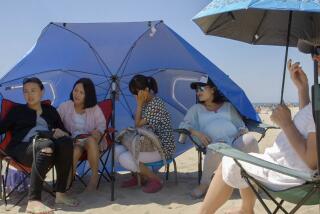Elisabeth Bing dies at 100; promoted Lamaze childbirth method in U.S.
- Share via
For much of the 20th century, the childbirth process in this country didn’t invite a lot of active participation from parents. Mothers in labor were given heavy doses of drugs, and fathers were banished to waiting rooms.
In the 1950s, physical therapist Elisabeth Bing rebelled against that. “A woman had become an unconscious object from whose pelvis a baby was extracted,” she wrote in a 1990 essay, “with no concern for her feelings or emotions.”
Bing played a key role in introducing the Lamaze childbirth method in the U.S. that put parents back into the picture. Her book “Six Practical Lessons for an Easier Childbirth” — published in the 1960s and still in print in an updated version — brought details of the method to a mass audience, sometimes to the consternation of doctors who felt a loss of control.
In nationwide television appearances and lectures, she became one of the top proponents of Lamaze and personally taught the method for more than 40 years.
Bing, 100, died Friday at her home in New York City. She had been in failing health and suffered from a form of vascular dementia, said her son, Peter Bing.
Lamaze uses breathing and relaxation techniques to mitigate the pain of childbirth, but Bing didn’t much like the term natural childbirth, preferring to call it prepared childbirth. And she was not entirely against the use of painkilling drugs.
“In my lectures, I made a special point of saying that there should never be feelings of guilt if a woman accepts medication,” she said in a 2000 interview for a Lamaze International publication. “I hope I never made anyone feel guilty.”
Bing was working in the 1940s as a physical therapist in a hospital in England when she first viewed childbirth. It was being treated more like a disease, she thought, than a joyous occasion.
“It was very frightening and upsetting to me,” she said in the 2000 interview. “The women either had very heavy anesthesia or nothing at all. They were entirely out of control. And they were treated very roughly.”
She read “Natural Childbirth,” a book by English physician Grantly Dick-Read considered radical for its time, and hoped to study with him, but the onset of World War II dashed those plans. Instead, Bing taught herself from his writings, and after moving to the U.S. in the late 1940s began teaching the techniques to pregnant women.
She found a powerful ally in Dr. Alan Guttmacher, chief of obstetrics at Mt. Sinai Hospital where she worked in New York.
Meanwhile in France in the early 1950s, Dr. Fernand Lamaze started using childbirth preparation and pain-management methods derived from techniques he learned in Russia. It involved active participation by the father or other “coach” to help the mother with breathing and other regimens. Bing learned it from Marjorie Karmel whose bestseller, “Thank You, Dr. Lamaze,” was about having a baby in Paris.
Bing and Karmel founded a nonprofit organization, later called Lamaze International, to promote the methods.
With the backing of Guttmacher, Bing switched from Read to Lamaze and her classes became increasingly popular, which rubbed some doctors the wrong way. At one point, she was called upon to appear before the entire obstetric staff to hear complaints. But at the beginning of the meeting, “Dr. Guttmacher said that the question of prepared childbirth would be discussed, but if anyone attacked Elisabeth personally, they would have to deal with him,” Bing said in the 1990 interview.
The debate was lively, but she was allowed to continue with her work.
The onset of the 1960s women’s movement helped propel nationwide interest in Lamaze, and Bing was thrust into the limelight, appearing on talk shows and giving lectures.
“I was constantly stimulated and motivated,” she said. “I did not plan anything like that. Life just sort of took me into it.”
She was born Elisabeth Koenigsberger in Grünau, a suburb of Berlin, on July 8, 1914. After high school she enrolled in a university but was asked to leave after only a few days because of her family’s Jewish heritage (her parents had converted to Protestantism years earlier, but were still targets of discrimination by Nazis and their sympathizers).
At 18 she fled to London and began studying physical therapy. Her interest in obstetrics came from her work with women who were often told, in those days, they needed several days of bed rest after birth.
Summing up her career in the 2000 interview, Bing said she was sometimes stopped on the street by people who had taken her classes decades ago.
“It does show me that, as the psychiatrists say, childbirth is a peak experience, and it stays with you no matter what else happens to you in your life.
“If I have helped people feel good about birth and about themselves, then I’m satisfied.”
In addition to her son, Bing is survived by a granddaughter. Her husband, Fred Bing, died in 1984.
Twitter @davidcolker
More to Read
Start your day right
Sign up for Essential California for the L.A. Times biggest news, features and recommendations in your inbox six days a week.
You may occasionally receive promotional content from the Los Angeles Times.







